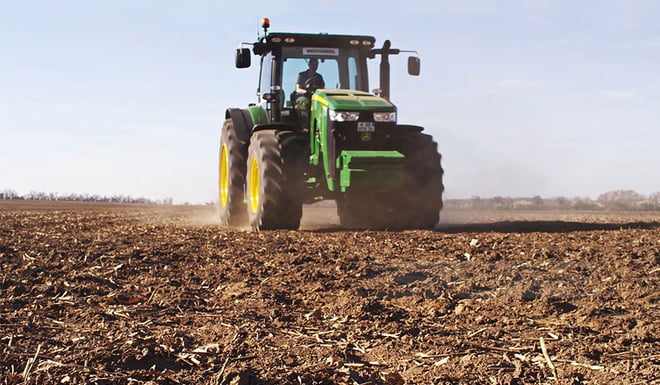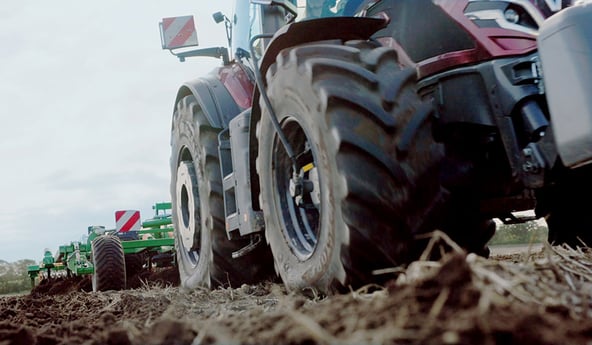Soil fertility is crucial to ensuring good yields, as the more your plant root systems can develop, the more productive your land will be.
Soil porosity is very important and corresponds to the space between mineral particle aggregates and organic matter. These pores allow water and air to circulate within the soil, but above all they enable your fertiliser inputs to infiltrate the deeper layers of soil and they allow the roots to develop to reach the deep water reserves during dry periods.
Intense ground work with heavy machinery can have a major impact on the structure of the fertile layers of soil. However, a well-adapted tyre with the right pressure settings will help preserve soil porosity, irrespective of the weight of your implements.
Here is how a good tyre can provide a solution for soil preservation and ensure long-term productivity.
1. Managing compaction in order to maintain soil fertility
Soil fertility corresponds to a good balance on both a nutritive and on a structural level, there being a continuous correlation between the two. If the structure is damaged, the soil is deprived of water and nutrients.
A good soil structure is made up of 45% mineral matter, 5% organic matter, 25% water and 25% air.
Soil that is in good health is a guarantee of optimal yields on a long-term basis.
On the other hand, with compacted soil, there is much less porosity as a result of the density of the soil. Water and air become rare, fertiliser inputs are blocked at surface level and the entire arable layer becomes impoverished.
Bad management of your tractor tyres, your load and inflation pressure can cause excessive soil compaction. This will lead to reduced yields over time.
Soil compaction is the result of multiple factors, the most common of which are as follows:
Compaction linked to excess load
To save time and improve productivity, we tend to overload our trailers. Yet the excess weight on each axle can lead to deep soil compaction, especially in wet conditions.
With an axle load of more than 5 to 7 tonnes, compaction can descend as deep as 2 meters below the surface, depending on your tyres.
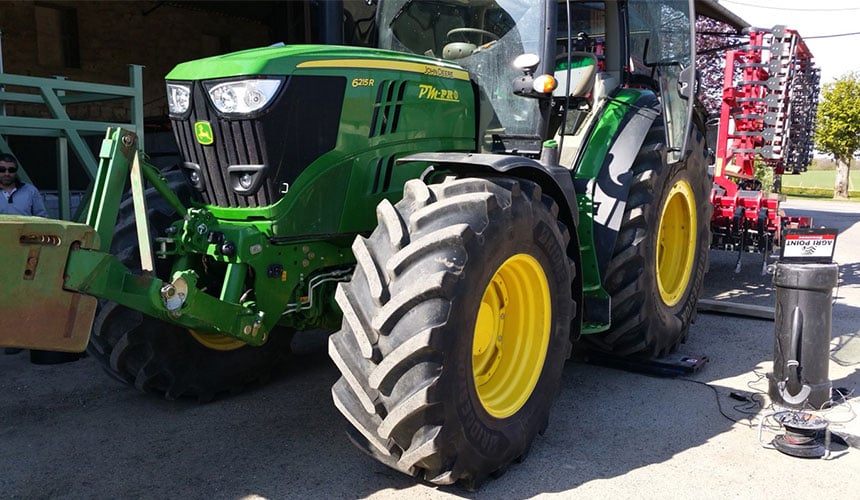
Compaction linked to overinflation
Another common form of compaction is surface compaction. This affects an area of up to 20 cm below the surface, in the upper layers of the soil, and is caused principally by overinflated tyres.
This phenomenon occurs essentially when you increase the inflation pressure in your tyres to cope with a heavy load, then maintain this fixed pressure permanently, without adapting your pressure settings to take account of whether you are driving on the road or in the fields or the different implements used.
Compaction linked to wet soil
Among the factors which encourage soil compaction, the moisture content of the soil should be taken into account before starting operations.
The wetter the land you work on, the higher the risk of soil compaction will be.
It is therefore better to work on dry soil to limit damaging your land in addition to causing wear to your tractor tyres.
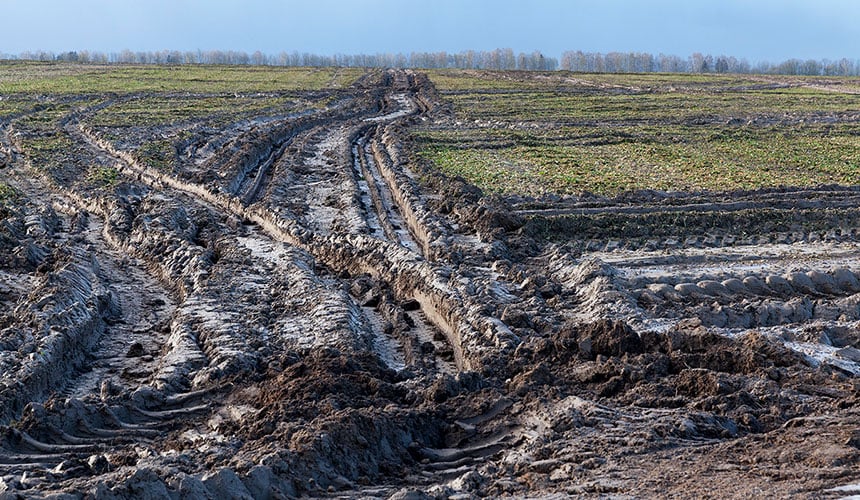
With tight management of these factors you can stay in control
If soil compaction is well managed, i.e. by avoiding excess loads and overinflation together with careful management of the hazards of bad weather conditions, soil fertility can be preserved.
The plants will be able to develop better root systems, which will limit disturbance to soil fauna.
Reducing compaction also leads to:
- Better soil drainage
- Better soil aeration to allow for good root respiration
- Deep soil water reserves for the dry season
- The diffusion of fertiliser or organic matter inputs, which reach the crop roots easily
- A richer biological life which helps to improve fertilisation
2. Better transmission of power to the ground to avoid compaction
In order to draw your implements, your machine must be able to transmit its power to the ground.
Power is the engine capacity, which shouldn’t be mistaken for torque which is the force necessary for movement during acceleration.
This force is exerted directly on the sidewalls, the lugs of the tyres and on the ground when you accelerate.
With too much torque (1850 rpm with unsuitable tyre dimensions, for example) the tyres will sink into the ground, because rolling resistance is high. This means that the tyres dig deeper into the soil until there is enough resistance to transmit movement.
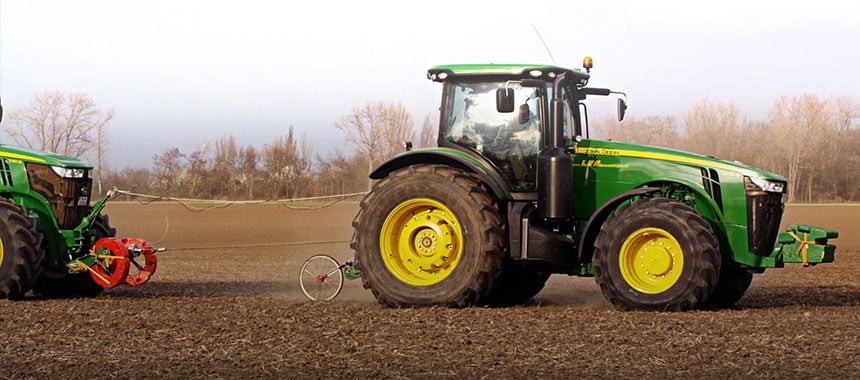
Control torque to preserve your soil
To avoid compaction, toque must be transmitted efficiently by using quality tyres which limit rolling resistance.
High-tech tyres which flatten out more on the ground, with more supple sidewalls and longer lugs, transmit more horizontal force, by gripping the ground perfectly, without causing in-depth damage.
3. Keep the slip ratio under control
Contrary to common belief, a minimum amount of slip is necessary to ensure traction and to make the tractor move forward. You must keep the slip ratio of your tyres under control to avoid loss of power.
When you work in the fields with heavy implements, it’s not such a good idea to increase the inflation pressure in your tyres because this reduces the tyres’ contact patch with the ground. If the tyre is overinflated, it tends to sink into the ground, thus increasing slippage, especially in wet conditions.
A correct slip ratio is below 15%. If there is too much slip, that is to say a ratio of over 18%, it is in your best interest to postpone operations and wait till the soil has dried out to avoid damaging the fertile layer of soil in your field.
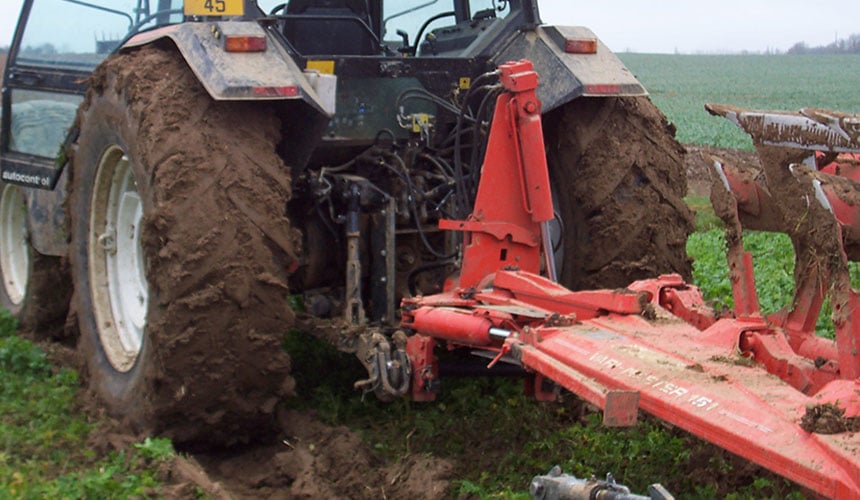
Increase the size of your soil footprint
There are several ways of controlling your slip ratio better and improving traction.
If you work in a region that tends to be damp, especially on clay type soils, the most efficient solution is to opt for a bigger tyre series (for example change from series 85 to 65).
The greater the section width, the less the tyre will sink into the ground.
A wider tyre flattens out onto the ground better with a low inflation pressure. This gives you a bigger contact patch, a longer, larger soil footprint and therefore a better grip on the ground.
Less slip means more traction
By controlling your agricultural tyres’ slip ratio, you optimise your machine’s traction.
You end up saving precious time by the close of each working day, while preserving your soil and extending the lifespan of your tyres.
4. Which tyre is best adapted to soil preservation?
The choice of tyre is essential in preserving soil fertility.
If you use bias-ply or discount tyres with heavy loads, you should expect a loss of yield linked to soil compaction of up to 20% or even 50% in certain situations.
To preserve your soil, buying VF agricultural tyres is certainly the most effective solution.
At Bridgestone, the low-pressure VT-TRACTOR tyre is an exceptional tool in the fight against soil compaction. This high-tech tyre has been designed to work constantly at a low inflation pressure (0.8 bar), which is not possible with a standard tyre.
There are many other advantages to be gained by opting for the VT-TRACTOR tyre:
High load capacity
The VT-TRACTOR tyre was designed to reduce the impact to the ground linked to load. It has reinforced sidewalls and a robust structure and can carry up to 40% more load than a standard tyre, at the same inflation pressure.
Soil preservation
By opting for the VT-TRACTOR tyre, you reduce soil compaction considerably, which allows you to obtain better yields in the long-term.
Thanks to its highly flexible sidewalls, the load is spread over a larger area, which is longer and wider, thus limiting the risk of compaction.
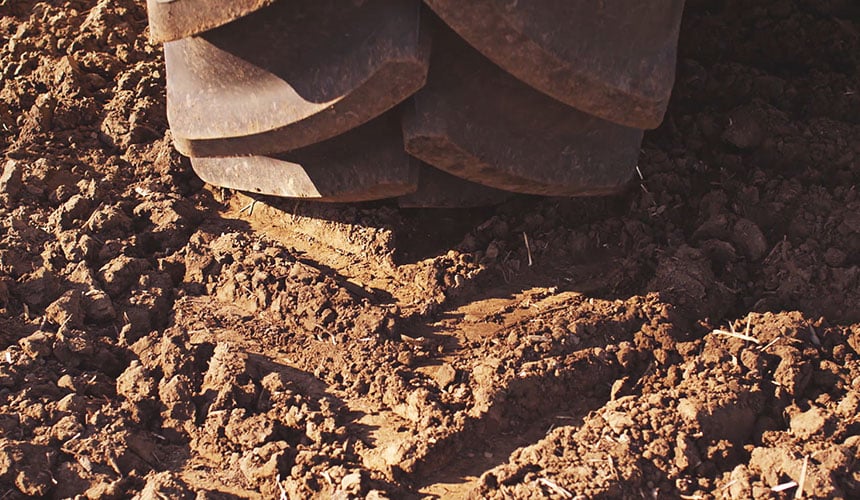
Soil preservation is much more important than it may seem at first glance. A well-aerated soil with a good soil structure will ensure that your crops receive the nutrients that are essential for their development, which will guarantee good harvests in the long-term.
The tyres that you choose have a direct impact on this outcome, so bear this in mind when it’s time to replace your agricultural tyres.
If you try to save money when it comes to buying your next set of tyres, the resulting cost in the long run will be much higher.
The bridgestone-agriculture.eu blog is written and administered by tractor tyre experts who can provide you with advice to help you achieve optimum productivity (Technical data on agricultural tyres - Agricultural tyre performance - Advice on agricultural tyre pressure - Soil compaction prevention - Sprayer tyre pressure - etc.)
To take it a step further and increase your farm’s profitability, the blog Bridgestone-agriculture.eu has prepared a free, highly detailed ebook which explains the essential role of the agricultural tyre on your productivity.
Most people who read this article have also read some of the following articles:
- 9 major points on soil compaction linked to tractor tyres
- What you need to know about soil compaction caused by your tractor tyres
- Protect your soil during harvest for successful sowing in the future
- How to reduce soil compaction after harvesting?
- What are the consequences of the soil compaction caused by my tractor tyres?
- 3 soil conditions to understand to avoid compaction by your tractor tyres
- What type of farming tyre is best for preventing ruts?
- Expert opinion on soil compaction caused by tractor tyres
- Demonstration of soil compaction linked to your tractor tyres
- Why analyse the soil footprint of your agricultural tyres?
This information is intended only to make you aware of the technical and functional aspects of agricultural tires and their use. It does not allow you to make a judgment or a definitive conclusion on a given problem. Only your agricultural tire expert is able to make a technical assessment and take a final decision, case by case.
Leave a
commentary
Your email address will not be published.
Required fields are indicated with *


